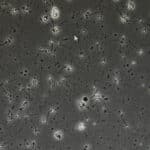Unless there is a family history of infertility, most people don’t consider that they might have fertility problems. However, if you have been trying to conceive for a year without success, it is advisable to see a specialist. And if you are over the age of 35, it is recommended you do so sooner, after six months. This is because female fertility gradually declines from that age onwards, so if there is a problem, it is important to identify it as soon as possible to avoid prolonged uncertainty and unnecessary delays.
Taking the first step and booking an appointment with a specialist can be daunting. Accepting that there may be a fertility problem is also challenging. But what often comes as the biggest surprise is when all the standard tests return as ‘normal’ and yet there is no explanation.
This scenario is technically referred to as unexplained or idiopathic infertility, and it remains controversial among experts, as the lack of a clear diagnosis makes it difficult to determine the most appropriate treatment strategy. In gynaecology, the term ‘female idiopathic infertility’ refers to a condition in which clinical examination does not reveal any pathological findings that could account for a couple’s difficulty in conceiving. However, some specialists argue that the term itself may be misleading, as there are certain fertility problems that cannot be detected through routine diagnostic procedures.
‘That is why it is so important to clearly define which diagnostic tests are needed before concluding that we are dealing with unexplained infertility’, explains Dr Josep Gonzalo, Consultant in Reproductive Medicine and Director of Dexeus Mujer in Reus.
Below, we address some frequently asked questions on this subject:
Is unexplained infertility common?
Yes. Unexplained infertility accounts for approximately 30% of all infertility cases, although this figure can vary from 8% to 37%, depending on how thorough the diagnostic assessment is.
Is there a typical patient profile?
Not exactly. However, it often affects younger women with normal ovarian function, unobstructed fallopian tubes, and no structural uterine abnormalities. That said, each case is different and also depends on clinical and geographical context.
What do standard fertility tests include?
A routine assessment includes taking a detailed medical, sexual and reproductive history; bloodwork with hormonal analysis; tubal studies (such as hysterosalpingography – HSG – or hysterosalpingo contrast sonography – HyCoSy); and a transvaginal ultrasound (ideally 3D) to rule out uterine abnormalities. If the patient has a male partner, a semen analysis according to WHO criteria is also recommended.
What conditions might not be detected by these initial tests?
Mild endometriosis, immune-related disorders, problems with endometrial implantation, and certain genetic or epigenetic abnormalities. These conditions typically require more specific or invasive testing to be identified.
What is the usual treatment approach for unexplained infertility?
The first step is to confirm the diagnosis by ruling out other causes and to estimate the likelihood of natural conception. This is an individualised prognosis made by the specialist. Depending on that prognosis, the options are either to wait a few more months or to begin fertility treatment.
What additional tests might be considered?
Endometrial receptivity analysis, immunological testing, genomic studies and diagnostic laparoscopy (only if endometriosis or another underlying condition is suspected). It is worth noting that few of these tests are backed by strong evidence, and their use is typically limited to research settings or specific clinical indications.
When is immunological testing recommended?
Only in selected cases with a relevant clinical history, such as recurrent pregnancy loss, known autoimmune conditions, or repeated implantation failure. It is not routinely recommended for all cases of unexplained infertility.
Is it advisable to keep trying to conceive naturally before starting fertility treatment?
Yes, but only if the prognosis for natural conception is good. According to predictive models, couples with a chance of conceiving within 12 months greater than 30% may be advised to try for another 6 to 12 months before starting fertility treatment, which can help avoid unnecessary interventions. It should be noted that lifestyle changes can also help improve fertility, such as quitting smoking, avoiding alcohol, maintaining a healthy weight, exercising for at least 30 minutes a day, limiting caffeine, reducing stress, and getting plenty of good-quality sleep.
If fertility treatment is recommended, what are the steps to follow?
The first-line treatment is usually intrauterine insemination (IUI) with mild ovarian stimulation, typically over 3 to 6 cycles. If this is unsuccessful, IVF may be considered. Intracytoplasmic sperm injection (ICSI) is only advised if male infertility has been identified.
How effective are the different fertility techniques in cases of unexplained infertility?
In patients with a poor natural prognosis, IUI with ovarian stimulation has been shown to improve pregnancy rates compared to expectant management. IVF has not shown clear benefits over IUI in this patient group. As for ICSI, it does not improve outcomes over conventional IVF unless male infertility is involved. In summary: for patients with unexplained infertility and a good prognosis, IVF does not offer better success rates than IUI, supporting a stepwise treatment approach.
But is there hope?
Absolutely. Despite the uncertainty surrounding unexplained infertility, many couples are able to conceive, either naturally or with treatment. Thanks to advances in reproductive medicine and the use of prognostic models, it is now possible to tailor treatment strategies, reduce unnecessary interventions, and improve outcomes.















